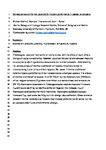Consequences of thermal plasticity for hypoxic performance in coastal amphipods
| dc.contributor.author | Collins, M | |
| dc.contributor.author | Truebano, M | |
| dc.contributor.author | Spicer, John | |
| dc.date.accessioned | 2022-04-19T08:40:44Z | |
| dc.date.available | 2022-04-19T08:40:44Z | |
| dc.date.issued | 2022-05 | |
| dc.identifier.issn | 0141-1136 | |
| dc.identifier.issn | 1879-0291 | |
| dc.identifier.other | 105624 | |
| dc.identifier.uri | http://hdl.handle.net/10026.1/19036 | |
| dc.description.abstract |
Physiological plasticity may confer an ability to deal with the effect of rapid climate change on aquatic ectotherms. However, plasticity induced by one stressor may only be adaptive in situ if it generates cross-tolerance to other stressors. Understanding the consequences of thermal acclimation on hypoxia thresholds is vital to understanding future climate-driven hypoxia. We tested if thermal acclimation benefits hypoxic performance in four closely-related amphipod species. The effects of thermal acclimation (7 days at 10 or 20 °C) on routine metabolic rate (RMR) and critical oxygen tensions (Pcrit) were determined at a standardised test temperature (20 °C). Gammarus chevreuxi and Echinogammarus marinus displayed increased Pcrit with acute warming but warm acclimation negated this increase. Pcrit of Gammarus duebeni was thermally insensitive. Gammarus zaddachi displayed increased Pcrit upon acute warming but little change via acclimation. Cross-tolerance between thermal plasticity and hypoxia may improve performance for some, but not all, species under future environmental change. | |
| dc.format.extent | 105624-105624 | |
| dc.format.medium | Print-Electronic | |
| dc.language | en | |
| dc.language.iso | en | |
| dc.publisher | Elsevier | |
| dc.subject | Acclimation | |
| dc.subject | Adaptive | |
| dc.subject | Plasticity | |
| dc.subject | Multistressor | |
| dc.subject | Temperature | |
| dc.subject | Hypoxia | |
| dc.title | Consequences of thermal plasticity for hypoxic performance in coastal amphipods | |
| dc.type | journal-article | |
| dc.type | Journal Article | |
| plymouth.author-url | https://www.webofscience.com/api/gateway?GWVersion=2&SrcApp=PARTNER_APP&SrcAuth=LinksAMR&KeyUT=WOS:000807471800001&DestLinkType=FullRecord&DestApp=ALL_WOS&UsrCustomerID=11bb513d99f797142bcfeffcc58ea008 | |
| plymouth.volume | 177 | |
| plymouth.publication-status | Published | |
| plymouth.journal | Marine Environmental Research | |
| dc.identifier.doi | 10.1016/j.marenvres.2022.105624 | |
| plymouth.organisational-group | /Plymouth | |
| plymouth.organisational-group | /Plymouth/Faculty of Science and Engineering | |
| plymouth.organisational-group | /Plymouth/Faculty of Science and Engineering/School of Biological and Marine Sciences | |
| plymouth.organisational-group | /Plymouth/REF 2021 Researchers by UoA | |
| plymouth.organisational-group | /Plymouth/REF 2021 Researchers by UoA/UoA07 Earth Systems and Environmental Sciences | |
| plymouth.organisational-group | /Plymouth/Users by role | |
| plymouth.organisational-group | /Plymouth/Users by role/Academics | |
| dc.publisher.place | England | |
| dcterms.dateAccepted | 2022-04-09 | |
| dc.rights.embargodate | 2023-4-15 | |
| dc.identifier.eissn | 1879-0291 | |
| dc.rights.embargoperiod | Not known | |
| rioxxterms.versionofrecord | 10.1016/j.marenvres.2022.105624 | |
| rioxxterms.licenseref.uri | http://www.rioxx.net/licenses/all-rights-reserved | |
| rioxxterms.type | Journal Article/Review |


